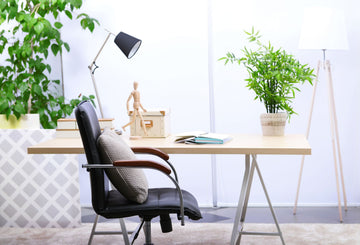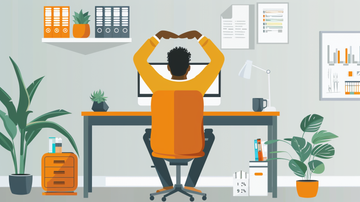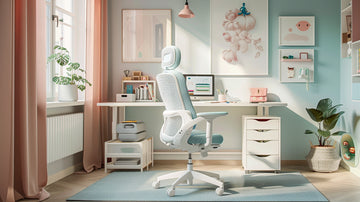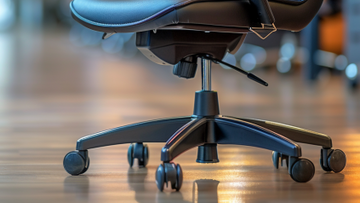Have you ever sat in your office chair and thought, "I need to get out of this thing ASAP"? If so, you're not alone. In fact, according to a recent survey by Staples and Herman Miller, the majority of American employees consider their workplace chairs uncomfortable. This isn't good news for workers—or employers. "Employees who use chairs that aren't supportive or adjustable are more likely to report lower back pain," says Anne-Marie Faiola, vice president of Global Workplaces at Herman Miller Inc., which is why it's important to make sure your office chair is set up correctly.
Get a footrest.
While it may not be the most exciting piece of furniture to add to your office, a footrest can be incredibly helpful in improving your posture. It's also great for your back and circulation, as well as propping up those tired feet. For those who don't want a permanent fixture in their office, a simple step stool or something similar will do the trick for getting in and out of chairs easily (and keeping blood flowing).
If you spend any amount of time typing at work, this will help with ergonomics by allowing you to stand while working without having to get off your chair whenever you need another document from the printer or want to refill your coffee cup. And if someone comes into your office looking for something specific and sees that there's no surface on which they could place their files? You'll have an answer for them: "Sorry—I have nowhere else to put them!"
Use a standing desk.
A standing desk is probably the most effective way to improve your posture and make your office chair more comfortable. Standing desks are typically used by people who want to avoid sitting all day. They can be used while working, talking on the phone, thinking, reading, or eating. A standing desk helps you keep better posture because it forces you to sit up straight when working at a computer or eating lunch at a tall table. It's also good for maintaining good posture when using an office chair without armrests (or if there's not enough space for arms).
add a pillow behind your back
You can add a pillow behind your back to get more support. This is especially helpful if you have a chair with a backrest, but it can also be useful if you don't have one. Simply place the pillow on the seat of your chair and lean back against it when sitting down. If there's no room for the pillow between the backs of your legs and the armrests, try wedging it underneath them instead (if possible).
If you don't want to buy a new office chair and still want some extra support behind your lower back, try sitting in an upright position with both feet flat on floor and knees at 90 degrees (or as close as possible). Bend forward at hips until torso is parallel with thighs; this will create space for placing another cushion or pillow behind back.
consider using a lumbar support pillow
Lumbar support pillows are designed to help relieve pressure on the lower back, making them ideal for office chairs. They can be used in any chair and can be especially useful if you're sitting for long periods of time. Lumbar support pillows do not need to be removed for use and can help improve posture, as well as prevent back pain.
move your armrests up or down
You can also move the armrests up and down manually. To do so, squeeze two levers on either side of each armrest and push them inwards until they stop moving. Some chairs will have separate levers for each armrest, some will have a single lever that raises or lowers both sides, and others may even use buttons instead of levers.
Whether you raise or lower your armrests depends on how tall you are compared to the height of your desk (or if you have a standing desk). If there's not enough room between your elbows and thighs when sitting down, then it might make sense for you to adjust them upwards; if there's plenty of space between those two points then it makes more sense for you to move them downwards instead. Many office chairs also come with an adjustable seat height option that allows users to change how high off the ground their chairs sit automatically; this will also affect how far forward or back their arms need to go in order for them still feel supported while working at their desks without getting too close or too far away from their monitors/keyboards/etcetera
adjust the chair seat tilt
-
Adjust the seat tilt so that the backrest is in line with your spine. If you're sitting upright, this means that the seat should be tilted slightly forward of level and if you're leaning back into a relaxed position, it should be tilted slightly backwards.
-
Adjust the chair to have your hips lower than your knees when seated. This is important for proper circulation and blood flow in your legs.
-
To achieve a proper seating position, adjust your chair so that both of your thighs are parallel to the floor when seated comfortably with feet firmly on floor or supported by footrest (if present).
adjust the chair's height
Adjust the height of your chair so that your feet can rest on the floor. If you don't have this option, consider using a footrest to help rest your feet on the ground.
making small adjustments to the chair itself can be helpful!
-
Adjust your chair height. If you've been sitting in a chair with arms for years, it's likely that the seat height is set to fit someone with longer legs than you. This can cause back pain and other issues because your knees aren't bent at a 90-degree angle when you sit down. So adjust the seat height so your thighs are parallel to the floor when sitting on it. You can also try lowering or raising the back of your chair if this doesn't help enough (many office chairs have adjustable backs).
-
Reconsider armrests. Armrests are handy for resting your hands on while typing or casually leaning on them when having conversations with coworkers, but they can restrict blood flow in certain parts of your body—like shoulders and elbows—and make it difficult to move around without accidentally bumping into things nearby! If possible, try removing armrests altogether; otherwise opt for ones that are lower than normal so they don’t stick out as much when seated all day long; finally consider rotating them inward so they face away from each other slightly more often than outward toward each other just so there isn’t any pressure on either side too often throughout each day instead
Conclusion
It’s important to remember that all of these tips are optional. If you’re still having trouble, then it may be worth investing in a new chair with more adjustable features. The best way to determine what chair will work best for you is by trying out different options in person at an office supply store or furniture store before making a purchase online.






